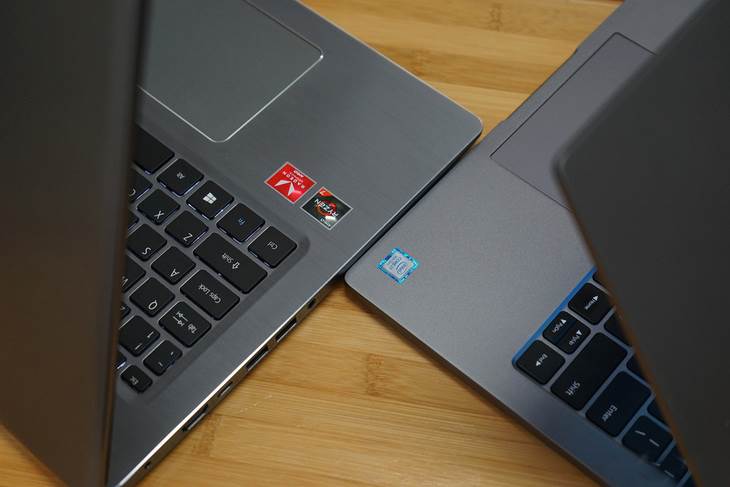The fight between Intel and AMD has been a topic of interest among hardware enthusiasts. Since 2006 Intel put out a new Core microprocessor architecture, while AMD has been gradually squeezed out of the high-end market and has to survive in the low-end market. Objectively speaking, Intel is indeed in a leading position in the competition with AMD. However, with the emergence of the Zen architecture in recent years, and the launch of the latest generation of APU at the beginning of this year, seems we see the dawn of AMD’s rising.
This dawn is evident on thin and light notebooks. ‘Thin and light’ is the most mainstream type of notebooks that cover different kinds of consumer groups, and today, the performance of light and thin cannot be underestimated. They can handle most of the office apps and some trendy games. Nowadays we can find two types of thin and light notebooks coming with Intel CPU & NVIDIA and AMD APU. Those ultrabooks sport i7-8550U processor with MX 150 graphics card and Ryzen 7 2700U with RX Vega 10 graphics.
Also Read: Xiaomi Mi Air Notebook Air (2018) Review

We are going to compare the Xiaomi Mi Notebook Air and the Acer Swift 3. The Xiaomi Mi Notebook Air uses an Intel processor and Nvidia entry-level graphics, while the Acer Swift 3 is equipped with an AMD processor. The former model comes with the 8th-gen Core chip, and its competitor is packed with the 8th-gen APU chip. The i7-8550U uses a quad-core architecture, while the R7 2700U comes with an eight-thread design.

The APU uses an all-in-one solution. The Vega 10 mobile graphics card and the processor share the power consumption. The Intel CPU has the core video card, but it is relatively weak. So it is generally equipped with another entry-level discrete graphics cards, the MX150. Obviously, the power consumption of the Ryzen 7 2700U 15W is lower than the sum of the 15W i7-8550U and the 8W MX150 low-power version.


We use the CineBench R15 to detect the computing power of the laptop processor. The Xiaomi Mi Notebook Air with the i7-8550U scored 522 points, and R7 2700U scored 605 points. We can also see that although the single-core performance of the APU processor is slightly lower, the multi-core score is quite satisfactory. It proves that AMD’s optimization of multi-core is doing a good job and the CPU score exceeds Intel’s latest quad-core low-voltage processing chip.



The results of 3DMARK FIRE STRIKE test on the graphics card show that Intel in conjunction with NVIDIA’s discrete graphics solution has achieved 2853 points, while the graphics score of Radeon Vega10 mobile graphics integrated with the APU is 2298 points. Actually, the Vega10’s specifications are not low, but it is limited by the sharing of power consumption with the CPU.

It is worth noting that although the memory of the Xiaomi Mi Notebook Air is a single channel, there is no obvious gap between single and dual channels for the entry level mainstream games. As for the Ryzen 7 2700U, it is another case. Its graphics card is integrated into the CPU. So the need for dual channel makes it better to release its performance.
In the game test, we choose shooter game with more CSGO players, turned on high quality, turned off anti-aliasing and vertical sync. In full HD resolution, the number of frames for both models is as follows:

The Xiaomi Mi Notebook Air equipped with the MX150 graphics card showed the highest frame count of 137FPS, while the lowest frame rate was 64FPS. Therefore, the average is 99.98FPS. The Acer Swift 3 integrated with the Vega10 mobile graphics card showed the highest frame rate of 85FPS, the lowest frame rate of 50FPS, and the average 66.72 FPS.

Obviously, the MX150 is ahead of the Vega 10 Mobile in actual frame rates. However, since the ultrabooks come with screens at only 60 Hz, it is actually difficult for the naked eye to feel the difference between the two.
A comparison of the running scores of BenchMark running in Tomb Raider 10 is as follows:

The NVIDIA discrete graphics score is only 21.48 FPS, while the Vega 10 mobile graphics score is only 12.79 FPS. Though the MX150 has a higher score, it cannot run the game smoothly with this number of frames.
When comparing the i7 8550U & MX150 and Ryzen 7 2700U, the former has better graphics performance, while the latter has more processor power. This result shows that nowadays in ultrabooks market, AMD can fully compete with Intel, and its mission of ‘rising’ has also achieved a certain stage of victory. In this kind of healthy competition, consumers benefit.

However, what we cannot ignore is that the cost of the dual Intel processor is slightly higher than the Ryzen 7 2700U processor. Plus, the superimposed power consumption means the cost of the thermal module will also increase. Even comparing the price of the processors alone, the cost of $385 for the i7 8550U is significantly higher than $225 for the R7 2700U. Reflected in the selling price, consumers who choose AMD’s slim solution can get a very similar experience with another solution at a more affordable cost. In the actual experience, the small advantage of the Ryzen 7 2700U processor is difficult to feel in the daily office, and most of the graphics performance of the MX150 is not used by most users.







